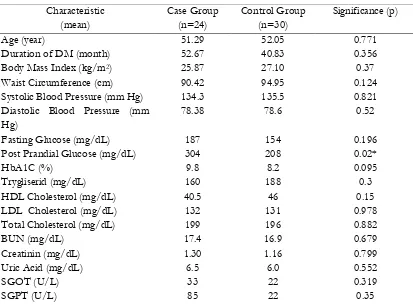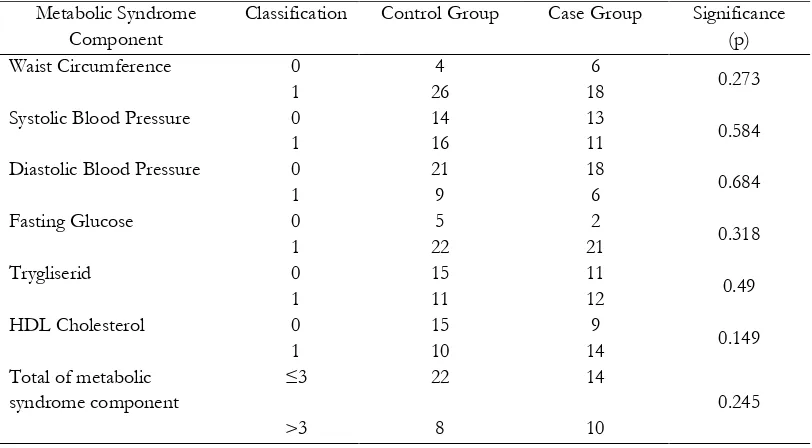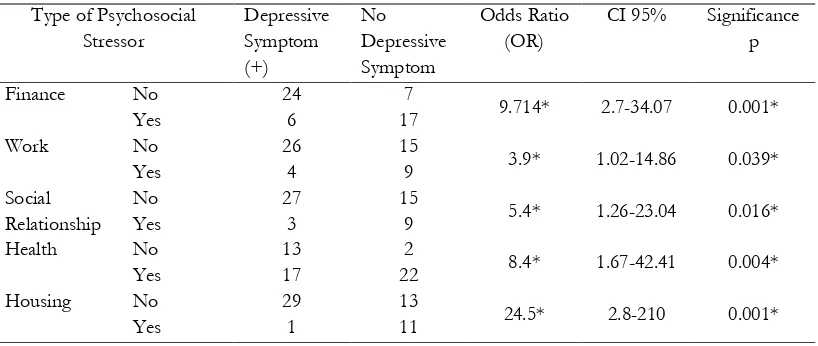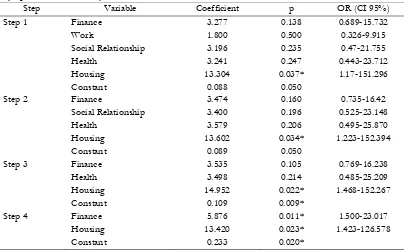Type of Psychosocial Stressor as Risk Factor of Depressive
Symptom in Metabolic Syndrome
Ana Fauziyati1, Agus Siswanto2, Luthfan Budi Purnomo3
1Specialty Training Program,Faculty of Medicine, Gadjah Mada University 2The Division of Psychosomatic, Internal Medicine Department, Faculty of Medicine,
Gadjah Mada University
3The Division of Endocrine, Metabolic and Diabetes, Internal Medicine Department,
Faculty of Medicine, Gadjah Mada University
Abstract
Background: Metabolic syndrome and depression are two major diseases over the world, which are increasing in prevalence over time. Depression is major mental health burden over the world. In long time, depression can lead to metabolic syndrome, while metabolic syndrome is risk factor for developing depression. Chronic stress that induced by psychosocial stressor lead to the development of both metabolic syndrome and depression. Further research is important to identify which type of psychosocial stressor is the risk factor for depression symptom in patient with metabolic syndrome.
Aims: This study is to identify the type of psychosocial stressor which could be the risk factor for depressive symptom.
Method: The study design was case control. The case group consisted of metabolic syndrome patients with depressive symptom, while the control group consisted of metabolic syndrome patients without depressive symptom. Metabolic syndrome was diagnosed based on International Diabetes Federation (IDF) criteria. Depressive symptom was measured by Beck Depression Inventory (BDI). Psychosocial stressors were measured by Stressful Life Events (SLE) questionnaire. Dependent variable was depressive symptom, while independent variables were type of psychosocial stressors (finance, work, social relationship, health and housing). Analysis methods that used in this study were independent t test, Pearson/Spearman correlation analysis, chi square and logistic regression.
Result: There were 54 patients in this study, consisted of 24 in case group and 30 in control group. There was no significant difference in most basic characteristics between two groups. There was significant difference of SLE score between two groups. Chi square analysis showed that housing, finance, health, social relationship, and work stressors were risk factors for developing depressive symptom in metabolic syndrome (OR 24.5; 9.7; 8.4; 5.4; 3.9 respectively, significant). Demographic factor which also influenced depressive symptoms was salary less than 1 million per month (OR 45, significant). According to logistic regression analysis, psychosocial stressors which most influenced the depressive symptom were finance and housing.
Conclusion: The study showed that housing, finance, health, social relationship and work stressors were risk factors for developing depressive symptomp in metabolic syndrome.
ABSTRAK
Latar belakang: Sindroma metabolik dan depresi adalah dua penyakit utama di dunia, yang semakin meningkat prevalensinya dari waktu ke waktu. Depresi adalah beban kesehatan mental utama di dunia. Dalam waktu lama, depresi dapat menyebabkan sindrom metabolik, sedangkan sindrom metabolik merupakan faktor risiko untuk mengembangkan depresi. Stres kronis yang disebabkan oleh stressor psikososial menyebabkan perkembangan sindrom metabolik dan depresi. Penelitian lebih lanjut penting untuk mengidentifikasi tipe stressor psikososial mana yang menjadi faktor risiko gejala depresi pada pasien dengan sindrom metabolik.
Tujuan: Tujuan dari penelitian ini adalah untuk mengidentifikasi jenis stressor psikososial yang dapat menjadi faktor risiko gejala depresi.
Metode: Desain penelitian adalah case control. Kelompok kasus terdiri dari pasien sindrom metabolik dengan gejala depresi, sedangkan kelompok kontrol terdiri dari pasien sindrom metabolik tanpa gejala depresi. Sindrom metabolik didiagnosis berdasarkan kriteria International Diabetes Federation (IDF). Gejala depresi diukur dengan Beck Depression Inventory (BDI). Stres psikososial diukur dengan kuesioner Stressful Life Events (SLE). Variabel dependen adalah gejala depresi, sedangkan variabel bebas adalah tipe stresor psikososial (keuangan, pekerjaan, hubungan sosial, kesehatan dan perumahan). Metode analisis yang digunakan dalam penelitian ini adalah uji t independen, analisis korelasi Pearson / Spearman, chi square dan regresi logistik.
Hasil: Ada 54 pasien dalam penelitian ini, terdiri dari 24 kelompok kasus dan 30 kelompok kontrol. Tidak ada perbedaan yang signifikan pada karakteristik dasar antara dua kelompok. Ada perbedaan skor SLE yang signifikan antara dua kelompok. Analisis kuadrat menunjukkan bahwa perumahan, keuangan, kesehatan, hubungan sosial, dan stres kerja merupakan faktor risiko untuk mengembangkan gejala depresi pada sindrom metabolik (OR 24,5; 9,7; 8,4; 5,4; 3,9 masing-masing signifikan). Faktor demografis yang juga mempengaruhi gejala depresi adalah gaji kurang dari 1 juta per bulan (OR 45, signifikan). Menurut analisis regresi logistik, stresor psikososial yang paling mempengaruhi gejala depresi adalah keuangan dan perumahan.
Kesimpulan: Penelitian ini menunjukkan bahwa perumahan, keuangan, kesehatan, hubungan sosial dan stres kerja merupakan faktor risiko untuk mengembangkan gejala depresi pada sindrom metabolik.
Kata kunci: stressor psikososial, sindrom metabolik, depresi
INTRODUCTION
Metabolic syndrome and
depression are two major diseases which are increasing over time because of sedentary lifestyle, including high calory intake and
poor physical activity1. About 15%
pupolation ever had major depression episode in their lives and about 6-8% out patients in primary health care met the criteria of depression. Depression was often undiagnosed2.
Depression makes the treatment of metabolic syndrome complicated. Some studies showed depression made the glucose control difficult in patient with
metabolic syndrome and diabetes
mellitus3,4,5. Depression decreased quality of
life 6,7. Depression increased the risk of
metabolic syndrome and cardiovascular disease8. In the other hand, metabolic
The relationship between metabolic syndrome and depression is bidirectional
10,11,12,13,14,15. There are some studies which
could not find the relationship between depression and metabolic syndrome16,17,18.
Psychosocial stressor in long time lead to depression. Type of psychosocial stressor include marital status, family problems, interpersonal relationship, work problem, environtment, law, finance and health19. Study showed subject with chronic
life stressor especially work and finance had higher risk for developing metabolic syndrome20.
Psychosocial stressor and chronic
stress increased the activity of
hypothalamus-pituitary-adrenal which
increased cortisol level in blood, which in long time caused the insulin resistance or
metabolic syndrome through central
obesity21,22. Hypercortisolism induced the
neurobiology imbalance in amigdala and frontal cortex that manifested in emotional
disorder, mood and depression23.
Psychosocial stressors which are not adapted well will induce the depressive symptomp19.
Problem in this study is what kind of psychosocial stressor which can be risk factor for developing depressive symptomp in metabolic syndrome.
Method
Design of the study is case control. Case group consist of patients with metabolic syndrome who have depressive symptom, while control group consist of patients without depressive symptom. The study was conducted at Dr Sardjito Central Hospital, from July 2014 until the minimum sample of subject achieved.
Subjects of the study are achieved from the population who meet the inclusion criteria and do not have exclusion criteria. Inclusion criteria for case group are: age
≥18 and ≤60 years’ old, signed informed consent and have depressive symptom with Beck Depression Inventory (BDI) score ≥ 14. Inclusion criteria for control group are: age ≥18 and ≤ 60 years old, signed informed consent and do not have depressive symptom (score of BDI <14). Exclusion criteria are: psychotic mental disorder, end stage of renal disease, congestive heart failure class functional IV, acute myocardial infarct, stroke or post stroke, diabetic ulcer, diabetes mellitus more than 10 years, using psychotropic agent, active smoker, alcoholic, and pregnant woman.
Sample of study subjects are collected with consecutive sampling with total 80 patients (40 in case group and 40 in control group). The measurement of sample size is based on case control design24.
Characteristic of study subject is presented in mean. Distribution of data was detected by normality test. To analyze the difference of mean between two groups we used t test. To determine the relationship
between psychosocial stressor and
depressive symptom we use chi square. To determine which psychosocial stressor to be the risk of depressive symptom in metabolic syndrome patient, we use multivariate analysis using logistic regression.
During the study, patients who meet the inclusion and exclusion criteria are asked about their history and psychosocial stressor, fulfill the Beck Depression Inventory and the Stressful Life Event
conducted to all patients, especially to measure height, weight, blood pressure, and waist circumference.
All the study subjects signed their informed consent to joint this study. This study was approved by Ethics Committee of Faculty of Medicine, Gadjah Mada University and had license from Director of Dr. Sardjito Central Hospital.
Result
There were 54 patients, consisted of 24 in case group and 30 in control group. Table 1 showed no differences of age, duration of diabetes mellitus, body mass index, waist circumference, systolic and diastolic blood pressure, fasting glucose, HbA1c, trygliserid, high density lipoprotein
cholesterol, low density lipoprotein
cholesterol, total cholesterol, blood urea nitrogen, creatinin, SGOT, SGPT, and uric acid between two groups. There was significant difference in post prandial glucose between two groups (304 vs. 208, p = 0.02). There was no difference between
proportions of demographic factors
between two groups, except income. Patient with income less than 1 million per month had higher risk for developing depression than patient with income more than 5 million per month (OR 45, CI 95% 3.4-584). Proportion of complication such as
retinopathy, nephropathy, neuropathy,
peripheral artery disease, coronary heart disease, and were not different between two groups.
Table 1 Baseline Characteristic between Case Group and Control Group
Characteristic
Waist Circumference (cm) 90.42 94.95 0.124
Systolic Blood Pressure (mm Hg) 134.3 135.5 0.821
Diastolic Blood Pressure (mm Hg)
Total Cholesterol (mg/dL) 199 196 0.882
BUN (mg/dL) 17.4 16.9 0.679
Creatinin (mg/dL) 1.30 1.16 0.799
Uric Acid (mg/dL) 6.5 6.0 0.552
SGOT (U/L) 33 22 0.319
Note: * significant; Education 1: no education and elementary school, 2: junior and senior high school, bachelor, 3: graduate and post graduate; Occupation 1: Unemployed, house wife, 2: Private, labor, farmer 3: government employment, retired, army, policeman, Income 1: <1 million/month, 2: 1-5 million/month, 3: >5 million/month, Marital Status 1: Never married, 2: married, 3: divorce/death spouse
Demographic Factor n (proportion %) OR (95% CI)
P
Education 1 4 (0.17) 3 (0.1) 4.0 (0.55-29.17)
p 0.171
2 17 (0.78) 18 (0.6) 2.83 (0.6-1.2)
p 0.164
3 3 (0.12) 9 (0.3) Referee
Occupation 1 5 (0.21) 9 (0.3) 0.9 (0.2-4.0)
p 0.947
2 12 (0.5) 9 (0.3) 2.28 (0.64-8.15)
p 0.202
3 7 (0.29) 12 (0.4) Referee
Income 1 9 (0.38) 2 (0.07) 45.0 (3.4-584)
p 0.004*
2 14 (0.59) 18 (0.6) 7.78 (0.88-68)
p 0.064
3 1 (0.42) 10 (0.33) Referee
Sex Female 13 (54.2) 16 (53.3) 0.97 (0.33-2.84)
p 0.951
Male 11 (45.8) 14 (46.7)
Marital Status 1 1 (0.042) 2 (0.07) 0.6 (0.05-7.0)
p 0.74
2 4 (0.17) 3 (0.1) 1.75 (0.35-8.79)
p 0.494
19 (0.79) 25 (0.83) Referee
Complication
Retinopathy Yes 5 (20.8) 7 (23.3) 0.86 (0.24-3.17)
p 0.826
No 19 (79.2) 23 (76.7)
Nephropathy Yes 5 (20.8) 5 (16.7) 1.32 (0.33-5.21)
p 0.695
No 19 (79.72) 25 (83.3)
Neuropathy Yes 10 (41.7) 8 (26.7) 1.96 (0.62-6.17)
p 0.245
No 14 (58.3) 22 (73.3)
Peripheral Artery Disease Yes 0 (0) 4 (13.3) 0.52 (0.39-0.68)
p 0.063 No 24 (100) 26 (86.7)
Coronary Artery Disease Yes 3 (12.5) 5 (16.7) 0.71 (0.15-3.35)
p 0.688 No 21 (87.5) 25 (83.3)
Stroke Yes 0 (0) 1(3.3) 0.55(0.43-0.70)
p 0.367
Chi square analysis showed no correlation between metabolic syndrome
component and total of metabolic
syndrome component with depressive symptom (table 2). There was significant difference of SLE total score, score of finance, social relationship, health and housing between two groups (table 3).
Pearson and Spearman correlation test showed that there were positive correlations between Beck Depression Inventory score with SLE total score (r = 0.688, p = 0.001), social relationship (r = 0.643, p = 0.007), health (r = 0.384, p = 0.01) and housing (r = 0.480, p = 0.032) (table 4).
Table 2 Correlation between Metabolic Syndrome Component and Depressive Symptom Metabolic Syndrome
Component
Classification Control Group Case Group Significance (p)
Waist Circumference 0 4 6
0.273
1 26 18
Systolic Blood Pressure 0 14 13
0.584
1 16 11
Diastolic Blood Pressure 0 21 18
0.684
1 9 6
Fasting Glucose 0 5 2
0.318
1 22 21
Trygliserid 0 15 11
0.49
1 11 12
HDL Cholesterol 0 15 9
0.149
1 10 14
Total of metabolic syndrome component
≤3 22 14
0.245
>3 8 10
Table 3 Comparison of Stressful Life Events (SLE) Score between Case and Control Group
SLE Score (mean) Case Group Control Group Significance(p)
SLE total score 12.2 4.63 0.001*
Finance 3.88 1.00 0.001*
Work 1.21 0.7 0.165
Social Relationship 1.04 0.33 0.023*
Health 4.92 2.2 0.001*
Housing 1.67 0.33 0.004*
Table 4 Correlation between SLE Score and BDI Score
Dependent Variable
Independent variable Pearson/Spearman Correlation (r)
Significance (p)
BDI Score SLE total score 0.688 0.001*
Finance 0.308 0.076
Work 0.171 0.423
Social Relationship 0.643 0.007*
Health 0.384 0.01*
Housing 0.480 0.032*
Note: * significant
Table 5 showed the high and significant Odds Ratio (OR) of all stressors, with the highest was housing (OR 24.5), and followed by finance (OR 9.714), health (OR 8.4), social relationship (OR 5.4), and
work (OR 3.9). Logistic regression showed that the most influencing factors for developing depressive symptom were housing and finance (table 6).
Table 5 Chi Square Analysis of Type of Psychosocial Stressors as Risk Factor for Developing Depressive Symptom in Metabolic Syndrome
Type of Psychosocial Stressor
Depressive Symptom (+)
No Depressive Symptom
Odds Ratio (OR)
CI 95% Significance p
Finance No 24 7
9.714* 2.7-34.07 0.001*
Yes 6 17
Work No 26 15
3.9* 1.02-14.86 0.039*
Yes 4 9
Social Relationship
No 27 15
5.4* 1.26-23.04 0.016*
Yes 3 9
Health No 13 2
8.4* 1.67-42.41 0.004*
Yes 17 22
Housing No 29 13
24.5* 2.8-210 0.001*
Yes 1 11
Table 6 Logistic Regression of Type of Psychosocial Stressor as Risk Factor for Developing Depressive Symptom in Metabolic Syndrome
Step Variable Coefficient p OR (CI 95%)
Step 1 Finance 3.277 0.138 0.689-15.732
Work 1.800 0.500 0.326-9.915
Social Relationship 3.196 0.235 0.47-21.755
Health 3.241 0.247 0.443-23.712
Housing 13.304 0.037* 1.17-151.296
Constant 0.088 0.050
Step 2 Finance 3.474 0.160 0.735-16.42
Social Relationship 3.400 0.196 0.525-23.148
Health 3.579 0.206 0.495-25.870
Housing 13.602 0.034* 1.223-152.394
Constant 0.089 0.050
Step 3 Finance 3.535 0.105 0.769-16.238
Health 3.498 0.214 0.485-25.209
Housing 14.952 0.022* 1.468-152.267
Constant 0.109 0.009*
Step 4 Finance 5.876 0.011* 1.500-23.017
Housing 13.420 0.023* 1.423-126.578
Constant 0.233 0.020*
Note: *significant
DISCUSSION
This study compared 24 patients in case group and 30 patients in control group. There was difference of post prandial glucose between two groups, that was significant higher in case groups (304 vs. 208, p=0.02). This is relevant with previous study which stated depression complicate blood glucose control in metabolic syndrome or diabetes patient3,4,5,25,26.
There was no correlation between
metabolic syndrome component and
depression. This result was different with previous study27,28. There was no difference
of complication propotion between two groups, that is good to minimalize bias. Income was correlated with depreesive symptom. This was relevant with previous study that stated low social economic level correlated with mental disorder in obese women29.
There was significant difference of type of psychosocial stressor between two groups. This evidence supported that
psychosocial stressor influenced the
developing of depression in metabolic syndrome23. Correlation test also showed
the moderate and high correlation between SLE total score, social relationship,
health and housing with BDI score. Chi square analysis showed that housing, finance, health, social relationship and work stressors were the risk factors for
developing depressive symptom in
metabolic syndrome. This result was
relevant with previous study that stated people with finance and work stressors had higher risk for developing metabolic syndrome20. This result was different with
Logistic regression showed that housing and finance stressors were the highest risk factors for developing depressive symptom in metabolic syndrome. This was relevant with previous study20.
CONCLUSION
Type of psychosocial stressors which defined as the risk factors for
developing depressive symptom in
metabolic syndrome were housing, finance, health, social relationship and work.
REFERENCE
1. Eckel, R.H., 2008. The metabolic syndrome. Chapter 236:1509-1513, in: Fauci, A.S., Braunwald, E., Kasper, D.L., Hauser, S.L., Longo, D.L., Jameson, J.L., Loscalzo, J. (Eds.).
Harrison’s Principles of Internal Medicine, 17th ed., McGraw Hill Medical, New
McGraw Hill Medical, New York. 3. Zuberi, S.I., Syed, E.U., Bhatti, J.A., 2011.
Association of depression with
treatment outcomes in type 2 diabetes mellitus: a cross sectional study from Karachi, Pakistan. BMC Psychiatry, 11(27):1-6.
4. Pouwer, F. & Snoek, F.J., 2001. Association between symptoms of depression and the glycaemic control may be unstable across gender. Diabetic Medicine, 18:595-598.
5. Zihl, J., Schaaf, L., Ziler, E.A., 2010. The
relationship between adult
neurophysiological profiles and diabetic
patient’s glycemic control. Applied Neurophysiology, 17:44-51
6. Eren, I., Erdi, O., Sahin, M., 2008. The effect of depression on quality of life of patients with type II diabetes mellitus
Depression and Anxiety, 25; 98-106. 7. Hyvarinen, M.P., Wahlbeck, K.,
Erickson, J.G., 2007. Quality of life and metabolic status in mildly depressed patients with type 2 diabetes treated
with paroxetine: a double-blind
randomized controlled 6-month trial.
BMC Family Practice, 8(34):1-7.
8. Vanhala, M, Jokelainen, J., Kiukaanniemi, K., S., Kumpuasalo, E., Koponen, H.,
2009. Depressive symptoms
predispose females to metabolic
syndrome: a 7 year follow up study.
Acta Psychiatrica Scandinavica, 119:137-142.
9. Dortland, R.A.K.B., Giltay, E.J., Veen, T., Zitman, F.G., Penninx, B.W.J.H.,
2010. Metabolic syndrome
abnormalities are associated with severity of anxiety and depression and with tricyclic antidepressant use. Acta Psychiatrica Scandinavica, 122:30-39. 10. Akbaraly, T.N., Ancelin, M.L., Jaussent,
I., Ritchie, C., Gateau, P.B., et al., 2011. Metabolic syndrome and onset of depressive symptoms in the elderly findings from the three city study.
Diabetes Care, 34:904-909.
11. Toker, S., Shirom, A., Melamed, S., 2008. Depression and the metabolic
syndrome: gender dependent
12. Heiskanen T., Viinamaki, H., Lehto, S.M., Niskanen, L., Honkanen, K., et al.,
2009. Association of depressive
symptoms and the metabolic syndrome in men. Acta Psychiatrica Scandinavica, 120:23-29.
13. Akbaraly, T.N., Kivimaki, M., Brunner, E.J., Chandola, T., Marmot, M.G., et al., 2009. Association between metabolic syndrome and depressive symptoms in middle-aged adults results from the Whitehall II study. Diabetes Care, 32(3):499-504.
14. Hartley, T.A., Knox, S.S., Fekedulegn, D., Leiker, C.B., Violanti, J.M., et al., 2012. Association between depressive symptoms and metabolic syndrome in police officers: results from two cross sectional studies. Journal of Environmental and Public Health, 1-9.
15. Meittola, J., Niskanen, L.K., Vinamaki, H., Kumpusalo, E., 2008. Metabolic syndrome is associated with self
perceived depression. Scandinavian
Journal of Primary Helath Care, 26:203-210.
16. Demirci, H., Cinar, Y., Bilgel, N., 2011. Metabolic syndrome and depressive symptoms in a primary health care setting in Turkey. Bulletin of Clinical Psychopharmacology, 21(1):49-57.
17. Hildrum, B., Mykletun, A., Midthjell, K., Ismail, K., Dahl, A.A., 2009. No association of depression and anxiety with the metabolic syndrome: the
Norwegian HUNT study. Acta
Psychiatrica Scandinavica, 120:14-22. 18. Foley, D.L., Morley, K.I., Madden,
P.A.F., Heath, A.C., Whitfield, J.B., Martin, N.G., 2010. Major depression
and the metabolic syndrome. Twin
Research and Human Genetics, 13(4):347-358.
19. Mudjaddid, E. & Shatri, H., 2009. Gangguan psikosomatik: gambaran umum dan patofisiologinya, in: Sudoyo,
A.W., Setiyohadi, B., Alwi, I.,
Simadibrata, M.K., Setisti, S. (editor).
Buku Ajar Ilmu Penyakit Dalam. jilid III, edisi V., page: 2093-2097. Interna Publishing, Jakarta.
20. Pyykkonen, A.J., Raikkonen, K., Tuomi, T., Erickson, J.G., Groop, L., Isomaa, B., 2010. Stressful life events and the metabolic syndrome. Diabetes Care, 33(2): 378-384.
21. Bjontorp, P., 2001. Do stress reaction
cause abdominal obesity and
comorbidities?. Obesity Reviews, 2:73-86. 22. Vogelzangs, N., 2010. Depression &
Metabolic Syndrome. Dissertation. Universiteit Amsterdam.
23. Sharpley, C.F., 2009. Neurobiological pathway between chronic stress and
depression: dysregulated adaptive
mechanisms?. Clinical Medicine: Psychiatry
2:39-45.
24. Dahlan, M.S., 2010. Besar Sampel dan Cara Pengambilan Sampel dalam Penelitian Kedokteran dan Kesehatan, ed. 3:46-60. Salemba Medika Publisher, Jakarta. 25. Toker, S., Shirom, A., Melamed, S.,
2008. Depression and the metabolic
syndrome: gender dependent
associations. Depression and Anxiety, 25:661-669.
27. Dunbar, J.A., Reddy, P., Lameloise, N.D., Philpot, B., Laatikanen, T., Kilkkinen, A., et al., 2008, Depression:
an important comorbidity with
metabolic syndrome in a general population, Diabetes Care 31: 2368-2373.
28. Kinder, L.S., Carnethon, M.R.,
Palaniappan, L.P., King, A.C.,
Fortmann, S.P., 2004. Depression and the metabolic syndrome in young adults: findings from the Third
National Health and Nutrition
Examination Survey. Psychosom Med
66:316 –322.
29. Gatineau, M. & Dent, M. 2011. Obesity and Mental Health. Oxford: National Obesity Observatory, pp:1-28.
30. Herva, A., Rasanen, P., Miettunen, J., Timonen, M., Laksy, K., Veijola, J., Laitinen, J., Ruokonen, A., Joukamaa, M, 2004. Co-occurrence of metabolic syndrome with depression and anxiety in young adults: the Northern Finland 1966 Birth Cohort Study. Psychosom Med



